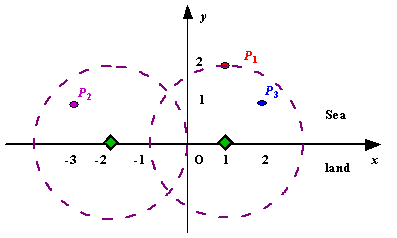Description
Assume the coasting is an infinite straight line. Land is in one side of coasting, sea in the other. Each small island is a point locating in the sea side. And any radar installation, locating on the coasting, can only cover d distance, so an island in the sea can be covered by a radius installation, if the distance between them is at most d.
We use Cartesian coordinate system, defining the coasting is the x-axis. The sea side is above x-axis, and the land side below. Given the position of each island in the sea, and given the distance of the coverage of the radar installation, your task is to write a program to find the minimal number of radar installations to cover all the islands. Note that the position of an island is represented by its x-y coordinates.

Figure A Sample Input of Radar Installations
We use Cartesian coordinate system, defining the coasting is the x-axis. The sea side is above x-axis, and the land side below. Given the position of each island in the sea, and given the distance of the coverage of the radar installation, your task is to write a program to find the minimal number of radar installations to cover all the islands. Note that the position of an island is represented by its x-y coordinates.

Figure A Sample Input of Radar Installations
Input
The input consists of several test cases. The first line of each case contains two integers n (1<=n<=1000) and d, where n is the number of islands in the sea and d is the distance of coverage of the radar installation. This is followed by n lines each containing two integers representing the coordinate of the position of each island. Then a blank line follows to separate the cases.
The input is terminated by a line containing pair of zeros
The input is terminated by a line containing pair of zeros
Output
For each test case output one line consisting of the test case number followed by the minimal number of radar installations needed. "-1" installation means no solution for that case.
Sample Input
3 2 1 2 -3 1 2 1 1 2 0 2 0 0
Sample Output
Case 1: 2 Case 2: 1
题意:将一条海岸钱看为X轴,X轴的上方为大海,海上有许多岛屿,给出岛屿的位置与雷达的覆盖半径,要求在海岸线上建雷达,
在雷达能够覆盖所有岛的基础上,求最少需要多少雷达。

1 #include <iostream> 2 #include <cstdio> 3 #include <cmath> 4 #include <algorithm> 5 #include <cstring> 6 #include <cstdlib> 7 using namespace std; 8 #define MAX 1005 9 struct sea 10 { 11 double left; 12 double right; 13 } a[1005]; 14 bool operator < (sea A,sea B) 15 { 16 return A.left<B.left; 17 } 18 int main() 19 { 20 int n,k=1; 21 double d; 22 while(cin>>n>>d&&(n||d)) 23 { 24 bool flag=false; 25 for(int i=0; i<n; i++) 26 { 27 double x,y; 28 cin>>x>>y; 29 if(fabs(y)>d) 30 flag=true; 31 else 32 { //计算区间 33 a[i].left=x*1.0-sqrt(d*d-y*y); 34 a[i].right=x*1.0+sqrt(d*d-y*y); 35 } 36 } 37 printf("Case %d: ",k++); 38 if(flag) 39 printf("-1 "); 40 else 41 { 42 int ans=1; //雷达初始化 43 sort(a,a+n); // 排序 44 double s=a[0].right; 45 for(int i=1; i<n; i++) 46 { 47 if(a[i].left>s) 48 { 49 ans++; //雷达加一 50 s=a[i].right; // 更新右端点 51 } 52 else if(a[i].right<s) 53 s=a[i].right; 54 } 55 printf("%d ",ans); 56 } 57 } 58 return 0; 59 }
